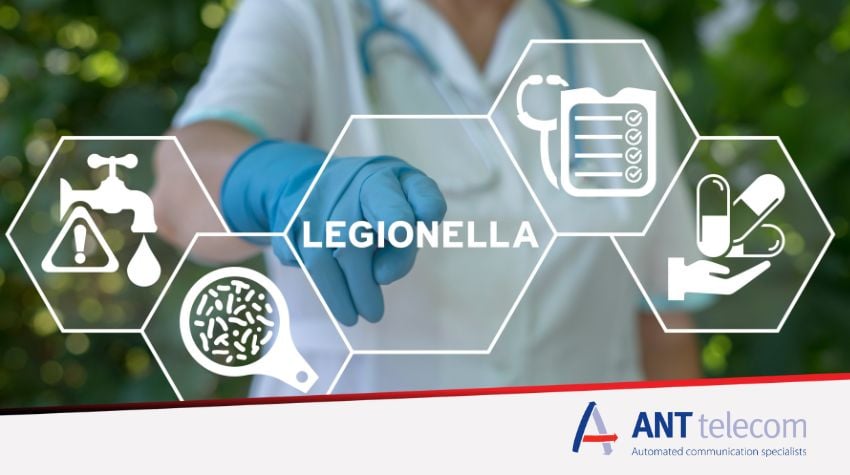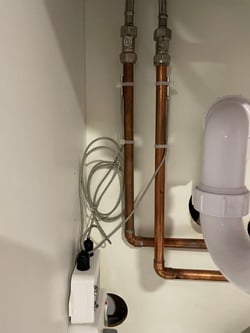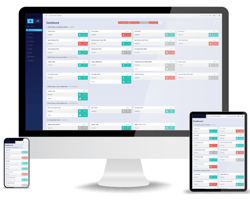
Controlling and reducing the risk of legionella growth is crucial for many organisations especially in Healthcare and Care Homes. To keep people safe and comply with regulations businesses must implement important and necessary measures, though for many they have become incredibly onerous.
In our latest blog we explain how our Automated Monitoring Solution using the latest IoT wireless sensor technology can help you to implement an automated process that not only reduces man power and saves money, but is far kinder to the environment.
Legionella bacteria can usually be found in small quantities in our natural water system e.g. rivers, lakes and reservoirs and isn’t considered harmful. Like most bacteria it grows and spreads when conditions are favourable and can lead to Legionnaires Disease if it gets into the lungs. This can happen when water droplets containing the bacteria are inhaled. Legionnaire’s disease is a form of pneumonia and can be very dangerous especially for the elderly and those with a pre-existing medical condition.
Legionella poses a risk where water is stored in purpose built systems e.g. in cooling towers, evaporative condensers, hot and cold water systems and spa pools.
To control the risk it’s important to keep water at the correct temperature to prevent growth. Cold water should be kept below 20°C and hot water above 60°C.
Incidents are more likely to occur when water is allowed to stagnate at temperatures between 20°C and 45°C. This can occur when there is a fault in the system or in rarely used outlets (like taps and showers).
It is the employers’ responsibility to implement the necessary control measures to tackle any risk in order to comply with the regulations. A risk assessment will uncover what the risks are and how best to manage them.
How are risks managed?
To prevent legionella growth organisations must have a process in place that monitors temperature of the water stemming from their hot and cold system tanks. This is usually done manually by measuring the temperature either on the pipework and/or water directly coming out from one of the outlets on a monthly basis. Taps and showers that aren’t used frequently are flushed through on a weekly basis. All activity must be documented and recorded to show that there is a robust process in place that manages the risk.
What challenges can businesses face?
In healthcare and care homes, it is essential to flush outlets that are rarely used twice a week to ensure the safety of patients and residents. However, the challenge lies in the fact that hospitals are unaware of which outlets are regularly used, leading them to flush all outlets as a precautionary measure. This not only poses a significant undertaking for hospitals with over 1000 taps and showers but also results in a concerning waste of water and energy, particularly if each tap is run for up to 5 minutes each time.
How can the latest technology help?
With so much time and effort required to manage the risks of legionella it’s not surprising that hospitals have looked to technology to alleviate some of the work and reduce the impact current processes have on the environment.
Sensor technology isn’t new but older systems haven’t provided a viable option. Hardwired sensors are too costly to install and wireless 2G, 3G, 4G and WiFi thermocouple sensors require too much maintenance to either re-calibrate or replace batteries to be of much use.
Constant temperature monitoring with LoRaWAN Wireless Sensors
However, our wireless temperature sensors use LoRaWAN technology. These wireless low powered, long range sensors provide the perfect answer. When installed they accurately measure and constantly record the temperature of the water in the tanks and running through the pipes.
With no cables to connect for power or connectivity our wireless IoT sensors are really easy to install. Batteries can last 3-5years (depending on the interval setting) and can transmit data up to 12KM (direct line of sight), which means that large campuses can be covered with a small number of 4G/LAN gateways. Temperature readings are accurate and readings only slip by 0.03C each year, which means regular annual calibration isn’t necessary.
are really easy to install. Batteries can last 3-5years (depending on the interval setting) and can transmit data up to 12KM (direct line of sight), which means that large campuses can be covered with a small number of 4G/LAN gateways. Temperature readings are accurate and readings only slip by 0.03C each year, which means regular annual calibration isn’t necessary.
Data from the sensors are automatically uploaded to our secure online portal that registered users can access via a web browser from any PC, Laptop or Smartphone. The portal application is really easy to use and shows real time information on a dashboard as well as in charts detailing how temperature changes throughout the day. Each sensor can be re-labelled and site maps and photos can be loaded to make it easy to distinguish one tap or tank from another and where they’re located.
Paperless monitoring and recording
With temperature readings recorded constantly 24/7 and 365 days of the year means staff will no longer need to create paper based records of their activity as the platform can generate reports automatically to show compliance.
Furthermore, reports can also be generated that show which taps and showers haven’t been used through normal daily activity and therefore needs to be flushed through. This can considerably reduce the number of taps that need to be flushed manually each week, saving a tremendous amount of time, water and energy - making the process for controlling legionella far more environmentally friendly.
haven’t been used through normal daily activity and therefore needs to be flushed through. This can considerably reduce the number of taps that need to be flushed manually each week, saving a tremendous amount of time, water and energy - making the process for controlling legionella far more environmentally friendly.
Temperature thresholds can be set up to alert users when certain breaches have occurred and immediate action is required.
Conclusion
Managing and controlling the risk of legionella growth manually can be very time consuming and expensive for many organisations and violate their corporate values. Using an Automated Monitoring Solution using the latest IoT sensors can help businesses to automate the process. This provides a far more efficient and effective method of controlling the risks and significantly reduces man power, saves money and is far better for the environment.
If you would like to know more information or a demonstration of an Automated Monitoring Solution, please get in touch with us. You can find all our contact details by clicking on the contact us tab at the top right of this page.



